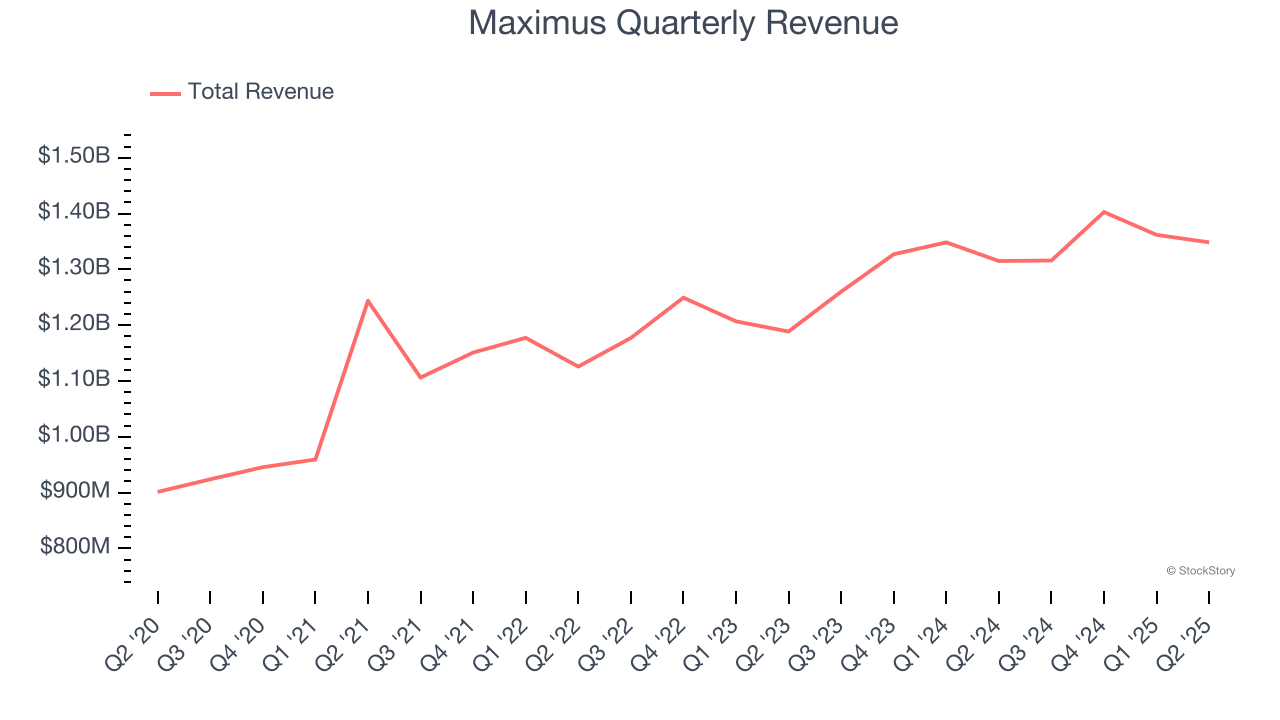
Government services provider Maximus (NYSE: MMS) reported Q2 CY2025 results exceeding the market’s revenue expectations, with sales up 2.5% year on year to $1.35 billion. The company’s full-year revenue guidance of $5.43 billion at the midpoint came in 0.6% above analysts’ estimates. Its non-GAAP profit of $2.16 per share was 40.7% above analysts’ consensus estimates.
Is now the time to buy Maximus? Find out by accessing our full research report, it’s free.
Maximus (MMS) Q2 CY2025 Highlights:
- Revenue: $1.35 billion vs analyst estimates of $1.32 billion (2.5% year-on-year growth, 2.5% beat)
- Adjusted EPS: $2.16 vs analyst estimates of $1.54 (40.7% beat)
- Adjusted EBITDA: $198.3 million vs analyst estimates of $150.5 million (14.7% margin, 31.7% beat)
- The company lifted its revenue guidance for the full year to $5.43 billion at the midpoint from $5.33 billion, a 1.9% increase
- Management raised its full-year Adjusted EPS guidance to $7.45 at the midpoint, a 15.5% increase
- Operating Margin: 12.3%, up from 10.8% in the same quarter last year
- Free Cash Flow was -$198.2 million, down from $164.6 million in the same quarter last year
- Market Capitalization: $4.22 billion
“Our third quarter results reflect once again the resilience of our business model that is underpinned by consistent delivery at scale of critical government services,” said Bruce Caswell, President and Chief Executive Officer.
Company Overview
With nearly 50 years of experience translating public policy into operational programs that serve millions of citizens, Maximus (NYSE: MMS) provides operational services, clinical assessments, and technology solutions to government agencies in the U.S. and internationally.
Revenue Growth
A company’s long-term sales performance can indicate its overall quality. Any business can experience short-term success, but top-performing ones enjoy sustained growth for years.
With $5.43 billion in revenue over the past 12 months, Maximus is one of the larger companies in the business services industry and benefits from a well-known brand that influences purchasing decisions.
As you can see below, Maximus’s 10.1% annualized revenue growth over the last five years was impressive. This shows it had high demand, a useful starting point for our analysis.

Long-term growth is the most important, but within business services, a half-decade historical view may miss new innovations or demand cycles. Maximus’s annualized revenue growth of 6.1% over the last two years is below its five-year trend, but we still think the results were respectable. 
This quarter, Maximus reported modest year-on-year revenue growth of 2.5% but beat Wall Street’s estimates by 2.5%.
Looking ahead, sell-side analysts expect revenue to grow 1.8% over the next 12 months, a deceleration versus the last two years. This projection is underwhelming and suggests its products and services will see some demand headwinds.
Unless you’ve been living under a rock, it should be obvious by now that generative AI is going to have a huge impact on how large corporations do business. While Nvidia and AMD are trading close to all-time highs, we prefer a lesser-known (but still profitable) stock benefiting from the rise of AI. Click here to access our free report one of our favorites growth stories.
Operating Margin
Operating margin is one of the best measures of profitability because it tells us how much money a company takes home after subtracting all core expenses, like marketing and R&D.
Maximus’s operating margin might fluctuated slightly over the last 12 months but has remained more or less the same, averaging 8.5% over the last five years. This profitability was mediocre for a business services business and caused by its suboptimal cost structure.
Analyzing the trend in its profitability, Maximus’s operating margin might fluctuated slightly but has generally stayed the same over the last five years. This raises questions about the company’s expense base because its revenue growth should have given it leverage on its fixed costs, resulting in better economies of scale and profitability.

In Q2, Maximus generated an operating margin profit margin of 12.3%, up 1.5 percentage points year on year. This increase was a welcome development and shows it was more efficient.
Earnings Per Share
Revenue trends explain a company’s historical growth, but the long-term change in earnings per share (EPS) points to the profitability of that growth – for example, a company could inflate its sales through excessive spending on advertising and promotions.
Maximus’s EPS grew at an astounding 16.9% compounded annual growth rate over the last five years, higher than its 10.1% annualized revenue growth. This tells us the company became more profitable on a per-share basis as it expanded.

Like with revenue, we analyze EPS over a shorter period to see if we are missing a change in the business.
For Maximus, its two-year annual EPS growth of 31.6% was higher than its five-year trend. We love it when earnings growth accelerates, especially when it accelerates off an already high base.
In Q2, Maximus reported adjusted EPS at $2.16, up from $1.74 in the same quarter last year. This print easily cleared analysts’ estimates, and shareholders should be content with the results. Over the next 12 months, Wall Street expects Maximus’s full-year EPS of $7.24 to shrink by 9.5%.
Key Takeaways from Maximus’s Q2 Results
We were impressed by how significantly Maximus blew past analysts’ EPS expectations this quarter. We were also excited its full-year EPS guidance outperformed Wall Street’s estimates by a wide margin. Zooming out, we think this quarter featured some important positives. The stock traded up 4.6% to $78.25 immediately after reporting.
Maximus put up rock-solid earnings, but one quarter doesn’t necessarily make the stock a buy. Let’s see if this is a good investment. What happened in the latest quarter matters, but not as much as longer-term business quality and valuation, when deciding whether to invest in this stock. We cover that in our actionable full research report which you can read here, it’s free.





